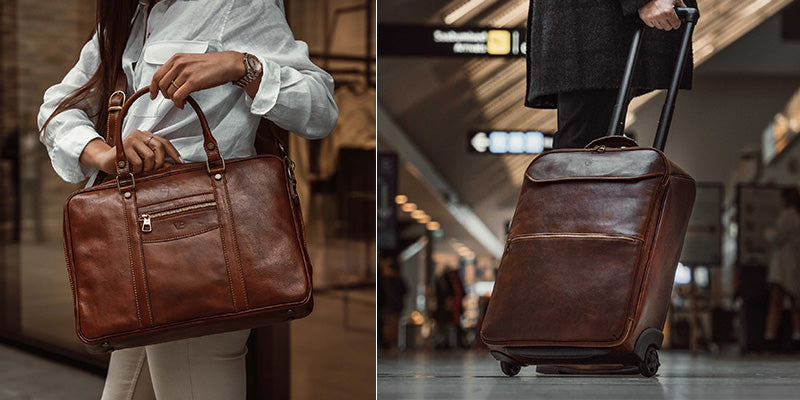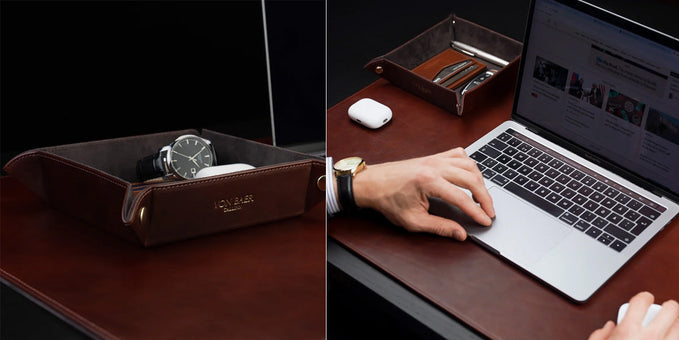Carry-on vs Personal Item 2025: Key Differences You Need To Know

Air travel is more popular than ever, but with different airlines having different baggage rules, packing for it can be challenging.
Some tickets include a personal item only, others a personal item and carry-on bag.
And this leads us to the question, what is the difference between the two?
The main difference between a carry-on and personal item is the size:
- Personal item - typical max size 18 x 14 x 8 inches or 45 x 35 x 29 cm + has to fit under the seat in front.
- Carry-on - typical max size 22 x 14 x 9 inches or 56 x 36 x 23 cm.
*Sizes and rules vary per airline, so read on for more specific advice + links for each.
Rules for Backpacks:
- A backpack counts as your personal item if it fits under the seat in front of you.
- If it's larger, a backpack counts as your carry-on bag, as long as it meets the size restrictions of the airline you're flying with.
Rules for Briefcases and Purses:
- In my experience, most briefcases and purses are small enough to count as your personal item, as they fit under the seat in front of you.
- However, check the airline requirements that you're flying with to make sure, as briefcase and purse sizes vary.
Looking for carry-on inspiration? Browse Von Baer's luxurious range here (new tab).
What Is A Carry-On Bag?
As the name suggests, a carry-on bag is a piece of luggage that you can take into the aircraft cabin. Typically, this is a small rolling suitcase, weekender bag, backpack, duffel bag, or tote.
How big can your carry-on bag be? In most airlines, your carry-on bag can be as big as 22 x 14 x 9 inches (56 x 36 x 23 cm) as long as it can be stowed safely in the overhead lockers in the cabin area. Check individual airline policies for the specific dimensions they allow. You should be able to stow it without the assistance of the crew.
What Is A Personal Item?
A personal item is a small bag that fits under the seat in front of you.
For most tickets, you can carry a personal item in addition to your carry-on bag.
Due to the size restrictions, personal items tend to be backpacks, laptop bags, purses, smaller duffels, bookbags, or camera bags.
Airlines all have different rules and regulations for personal items, so you need to check the size and weight restrictions before you fly.
Most importantly, your personal item must be small enough to fit under the seat in front of you, even if it is your only piece of cabin baggage.
How big can your personal item be? In most airlines, your personal item can be as big as 18 x 14 x 8 inches (45 x 35 x 29 cm) as long as it fits under the seat in front of you. Check individual airline policies for the specific dimensions they allow.
What is the Difference Between a Carry-On and a Personal Item?
As personal items and carry-on bags are both pieces of cabin luggage, travelers often confuse the two.
Here we explain the differences to help you categorize your baggage before you board:
Carry-On Bags at a Glance:
- A wheeled trolley, tote, or backpack measuring no more than 22 x 14 x 9 inches or 56 x 36 x 23 cm
- Maximum weight 15-22lbs depending on the airline
- Must be small enough to fit in the overhead bin
- Often included with low-cost carriers instead of checked baggage
Personal Items at a Glance:
- A purse, laptop bag, briefcase, or small duffel measuring no more than 18 x 14 x 8 inches or 45 x 35 x 29 cm.
- Typically, no weight restrictions apply
- Must fit under the seat in front of you
- Included free of charge with all tickets, even basic economy options with budget airlines
Here are the websites of popular airlines to check the up to date information:
Pros and Cons of Carry-On Bags
Many travelers, especially business travelers, prefer to fly with a carry-on bag.
Why?
They provide quick and easy access to valuables and personal belongings during the flight, they eliminate waiting time at the luggage carousel, and they can save money on checked bag fees.
If you pack all your clothes, toiletries, and tech essentials in a carry-on bag, you’ll never have to worry about lost baggage, and you can be confident that your luggage will arrive at your destination at the same time as you.
However, if you travel with a carry-on bag only, you need to master the art of packing light.
They are much smaller than checked baggage, often measuring no more than 22 x 14 x 9 inches, and most airlines limit the weight of these bags to just 22lbs or 10kg.
If your carry-on is oversized or overweight, the airline may charge you a fee to check your bag at the gate, making it a costly start to your trip.
Related pages:
- Best Carry-on Luggage
- Leather Carry On Luggage
- Best Carry On Luggage for American Airlines
- Is a Garment Bag a Personal Item?
- Personal Item Bags
- Is a Backpack a Personal Item
- Personal Item Backpacks
- Is a Duffel Bag a Personal Item
Pros and Cons of Personal Items
Personal items are free of charge, and any free luggage is a bonus, but you need to consider size restrictions when shopping for this bag.
Typically, your personal item must fit under the seat in front of you and measure no more than 18 x 14 x 8 inches, although this varies by airline.
Another pro of personal items is that you can access them throughout your journey, so they are ideal for keeping valuables, prescription medicines, cosmetics, and tech accessories close to hand during your flight.
The cons of personal items are few, but size limitations would be one of them.
And, of course, you must carry them in addition to any other pieces of cabin baggage, duty-free purchases, travel pillows, and jackets. So, they may weigh you down.
How To Pack A Carry-On Bag
If you learn to pack light, a carry-on bag could be all you need for your business trip, weekend away, or even a week at the beach.
In addition to your scaled-down wardrobe, you can pack your laptop, headphones, tech charger, travel-size toiletries, and any medications you need in your carry-on, confident that it will be with you throughout your flight.
Packing mix-and-match items will help you maximize space in your carry-on bag, as will reducing bulky items such as handbags and shoes.
Related pages:
- Best Travel Bags
- Best Lightweight Luggage
- Small Travel Bags
- Under Seat Travel Bags
- Minimalist Travel Bags
- Best Soft Sided Luggage
- Best Time to Buy Luggage
How To Pack A Personal Item
Packing a personal item is an art form, especially if you struggle to pack light, but every traveler should take advantage of this free piece of cabin baggage.
If traveling with a personal item and a carry-on only, make sure your bags are big enough to carry everything you need but small enough to fall within the airline’s sizing guidelines.
Pack all your clothes, toiletries, and accessories in your carry-on and use your personal item for your valuables, travel documents, tech and chargers, headphones, prescription medicines, snacks, and any other items you may need during your flight.
Expert Packing Tips for Air Travel
Master the art of packing light and never pay excess baggage fees again. It will change the way you travel, so we’ve compiled our list of expert packing tips for personal items and carry-on bags to help you travel like a pro:
-
Invest in compression packing cubes. You’ll get double the amount of clothes in your carry-on, and they’ll help you organize your travel wardrobe.
Browse and purchase compression packing cubes in the style of your choice here.
- If you cannot use packing cubes, roll your clothes to maximize space. You’ll be surprised at how much space you’ll save, and as rolled clothes do not wrinkle as easily as folded clothes, you won’t need to iron them when you arrive at your destination.
- Wear heavier items, such as winter jackets and boots. You can remove your warmer clothing onboard and store it in the overhead compartment, so don’t waste valuable packing space by squeezing it into your carry-on.
- Plan your wardrobe and pack mix-and-match items.
- Don’t take full-size toiletries, but decant them into smaller travel-sized containers, or buy them when you arrive at your destination to save space in your carry-on.
Size & Shape of Personal Item vs Carry-On Bags
The only real difference between a personal item and a carry-on bag is the size and shape of each.
The most popular carry-on is a wheeled trolley, either soft-shell or hard-case, in a rectangular shape. Manufacturers design these to fit into the overhead bins, and while sizes vary, they are typically no more than 22 x 14 x 9 inches.
A personal item can be anything from a purse or tote to a backpack, duffel bag, or briefcase. As these items must fit underneath the seat in front of you, they are smaller, measuring no more than 18 x 14 x 8 inches.
Sizes vary – so please check the baggage policy on your airline’s website.
What You Should Not Pack in Personal Items & Carry-Ons
As personal items and carry-on bags go inside the aircraft, there are certain items you can and cannot pack inside.
You’ll find a comprehensive guide to prohibited items on the TSA website, but here we list the most common restrictions:
- Explosives
- Flammable items
- Sharp objects
- Firearms
- Liquids and gels larger than 3.4oz or 100ml, anything larger, will be confiscated and destroyed by airport security.
- Sports equipment, including golf clubs, snowboards, tennis racquets, and skis. Airlines have a whole new set of rules for sports equipment, so please check their website for further details.
Additional Items you CAN Carry Onboard
Some airlines, such as Delta and American Airlines, allow you to bring additional items onboard free of charge. These include umbrellas, coats, diaper bags, reading materials, camera bags, and food or duty-free goods purchased at the airport.
So, take advantage of these bonus items wherever possible.
How To Avoid Overweight & Oversize Baggage Fees
If you want to avoid overweight and oversized baggage fees, always read the airline's baggage policy, particularly if you have a ticket with a low-cost carrier.
While almost all airlines allow you to carry a personal item free of charge, many impose strict size and weight restrictions, and if you exceed them, you could have to pay $50 or more at the check-in desk. The same applies to carry-on bags.
Read Airline-Specific Baggage Policies Before Leaving Home
As every airline has its own baggage policy, it is essential that you read it before packing your personal item and carry-on bag.
Almost every airline we reviewed had different carry-on rules, so never assume one airline has the same rules as another.
Here’s what you should look out for:
- Size and weight restrictions. It may seem pointless, but measuring your personal item and weighing your carry-on could save you a fortune on overweight baggage fees. Once you are at the airport, it’s too late to make any changes, so act well before your trip.
- Make yourself familiar with the airline’s list of prohibited items. While most items are allowed in checked baggage (except explosives and flammables), the TSA prohibits many carry-on items, such as sharp objects, cigarette lighters, and liquids exceeding 3.4oz.
- Do you need to carry a special item, such as medicine injects, sports equipment, or a musical instrument? Check with your airline before you travel. Some medications require a written letter from your doctor, and airlines typically have separate rules for bulky or oversized equipment.
Should You Take a Carry-On, Personal Item, or Both?
Now you have a better understanding of personal items and carry-ons, you can decide which is best for your trip. But there are still a few things to consider:
Going on a long trip? If so, you will likely need a personal item and a carry-on to transport your essentials. If you cannot get everything you need in those two bags, the only option is to pay extra for a checked bag, but it could add a substantial amount to the cost of your trip.
If you are heading off on a short business trip, a personal item such as a briefcase may be enough to hold a clean shirt and your tech essentials, but if you are traveling for more than one night, a carry-on bag makes more sense.
Traveling with fragile items?
They are more likely to survive the flight if you pack them in your cabin luggage, so bear this in mind when purchasing a carry-on or bag that falls within the personal item category.
Is a carry-on bag really cheaper than a hold bag? Check the airline's policy before you decide. A hold bag could cost just $10 more than a carry-on bag but offer double the weight allowance.
Guide to Choosing the Perfect Backpack for Air Travel
Backpacks are ideal for air travel. They are typically lighter than wheeled rollers, easier to carry than briefcases, and more spacious than laptop bags.
They are the ultimate carry-all for frequent fliers, and in this guide to choosing the perfect backpack for air travel, we’ll help you find the best model to use as your free personal item or carry-on.
Benefits of Backpacks for Travel
The beauty of backpacks is that they come in various shapes, sizes, and styles to suit every traveler, and you can use them to transport anything from laptops and cosmetics to tech accessories, inflight reading materials, foods, drinks, and snacks. And even a change of clothing.
Thanks to their ergonomic design, backpacks evenly distribute weight across the back and shoulders so you can go hands-free when navigating busy airports and cities.
They are perfect for land and air travel; you just need to find one that meets your needs. Here are our top tips:
- Backpack Size: If you intend to use your backpack as a personal item or carry-on bag, check it meets airline size requirements. For flights, choose a smaller backpack measuring no more than 18 x 14 x 12 cm (when packed), and you can use it as a personal item or a carry-on.
- Backpack Comfort: It is always recommendable to try on a backpack before you buy. Wide shoulder straps, waist straps, and padded back panels make them much more comfortable to wear over long periods, so if you intend to use yours for sightseeing and activities, choose comfort over style.
- Backpack Organization: Modern manufacturers equip their backpacks with a spacious interior compartment and multiple exterior pockets, water bottle holders, laptop compartments, and tech pouches. Check your preferred model to see if it has all the organization you need.
- Backpack Material: Leather backpacks may be more aesthetically pleasing than canvas backpacks and nylon backpacks, but they might not be the best option for those who intend to wear them outside in all weather conditions. Consider how and where you will wear your backpack and choose a material that best meets your needs.
Pack Light And What You Need
We’ve said it before, but master the art of packing light, and you’ll never need to worry about overweight or excess baggage fees again. It sounds simple, we know, but you really don’t need to pack a different outfit for every day of your vacation, and dare we say it, you don’t need seven pairs of shoes!
Planning your vacation wardrobe before you leave home will make your trip more enjoyable, and once you have developed your skill of mixing and matching items, you’ll be surprised at just how many outfits you can style from four or five well-thought-out pieces.
Of course, if you are heading off on a cruise with formal events, a mountain expedition that requires climbing boots and equipment, or an extended business trip, packing light might not be an option.
But if you want to save money on domestic flights and short overseas adventures, the easiest way is to travel with a personal item and carry-on bag and leave the checked bag behind.
Personal Item & Carry-On FAQs
Do you still have questions regarding personal items and carry-on bags? Find the answers in our most commonly asked FAQs below:
1. Can I Take a Personal Item and a Carry-On Onboard?
The answer to this question depends on the conditions of your ticket. If you have purchased a basic economy ticket with a low-cost carrier such as Frontier or Allegiant, your ticket likely includes a personal item, not a carry-on bag.
However, you may be able to add a carry-on bag for a small additional fee, so check before you complete your purchase.
2. How Many Personal Items Can I Carry? Can I Take 2 Personal Items Instead of One Carry-On Bag?
If your ticket includes a personal item and a carry-on bag, you can take two personal items instead, where one of them counts as your carry-on bag (provided they meet the airline size limits).
If your ticket only includes a personal item, you should never attempt to carry two pieces onboard.
3. Can you get away with taking an extra personal item onboard?
It is certainly possible, but it's risky. The trick here is to buy something from the airport, then stash the personal item in the large bag your airport purchase comes in, thereby concealing the fact that it also includes an additional bag.
Most of the time, duty-free purchases will not count towards your carry-on allowance, but it's a risky strategy to proceed with caution.
If you have an upgraded ticket such as business class, you'll likely already have an extra carry-on allowance, so in that case, you can take an extra personal item or carry-on bag onboard.
4. Can I Use a Backpack as a Personal Item or Carry-On?
Yes, provided it falls within the size guidelines on the airline’s website, you can use a backpack as a personal item or carry-on bag.
Just remember that it needs to fit comfortably under the seat in front of you if it’s a personal item and in the overhead compartment if it is a carry-on.
5. Do All Flights Allow a Personal Item?
In my experience, every single flight I've ever been on has allowed at least one personal item onboard.
It's more common these days to find flights offering personal items only, meaning that a carry-on bag is an added upgrade, but I've never seen the same for personal items.
There may be exceptions out there, so it's worth double-checking with the airline, but I'm 99% sure all flights allow a personal item.
6. Is a Purse Considered a Carry-on?
No, in most cases, a purse is considered a personal item, not a carry-on. This is because their small size tends to mean they can fit under the seat in front of you (and, therefore, be used as a personal item).
However, if it's a very large purse that doesn't meet the airline personal item requirements, then yes, it would be considered your carry-on bag.
7. Is a Laptop Bag Considered a Carry-on?
No, in most cases, a laptop bag is considered a personal item, not a carry-on. This is because their small size tends to mean they can fit under the seat in front of you (and, therefore, be used as a personal item).
However, if it's a very large laptop bag that doesn't meet the airline personal item requirements, then yes, it would be considered your carry-on bag.
Conclusion
We hope you enjoyed our article on carry-on vs personal item.
If you have any questions or comments, contact us at info@vonbaer.com, or leave them in the comments.
Want to read more? Check out our Travel pages here.

Author: Albert Varkki
Albert Varkki is the co-founder of Von Baer. He understands leather products as a consumer, supplier, and a manufacturer, helping you with the inside knowledge you need, to choose the perfect leather product for you.
We strive for the highest editorial standards, and to only publish accurate information on our website.
Leave a Comment
Your email address will not be published.









